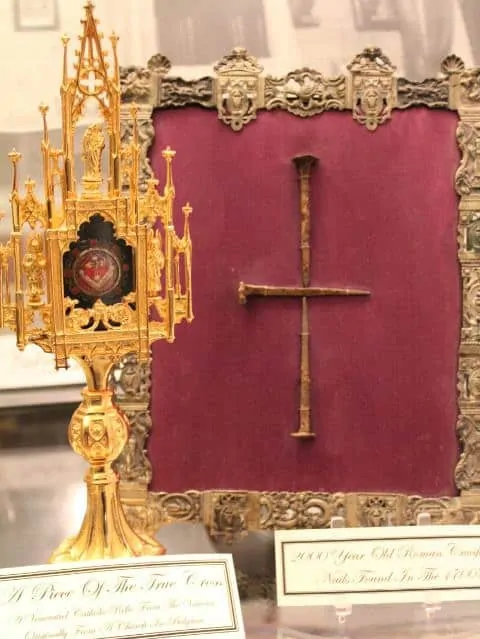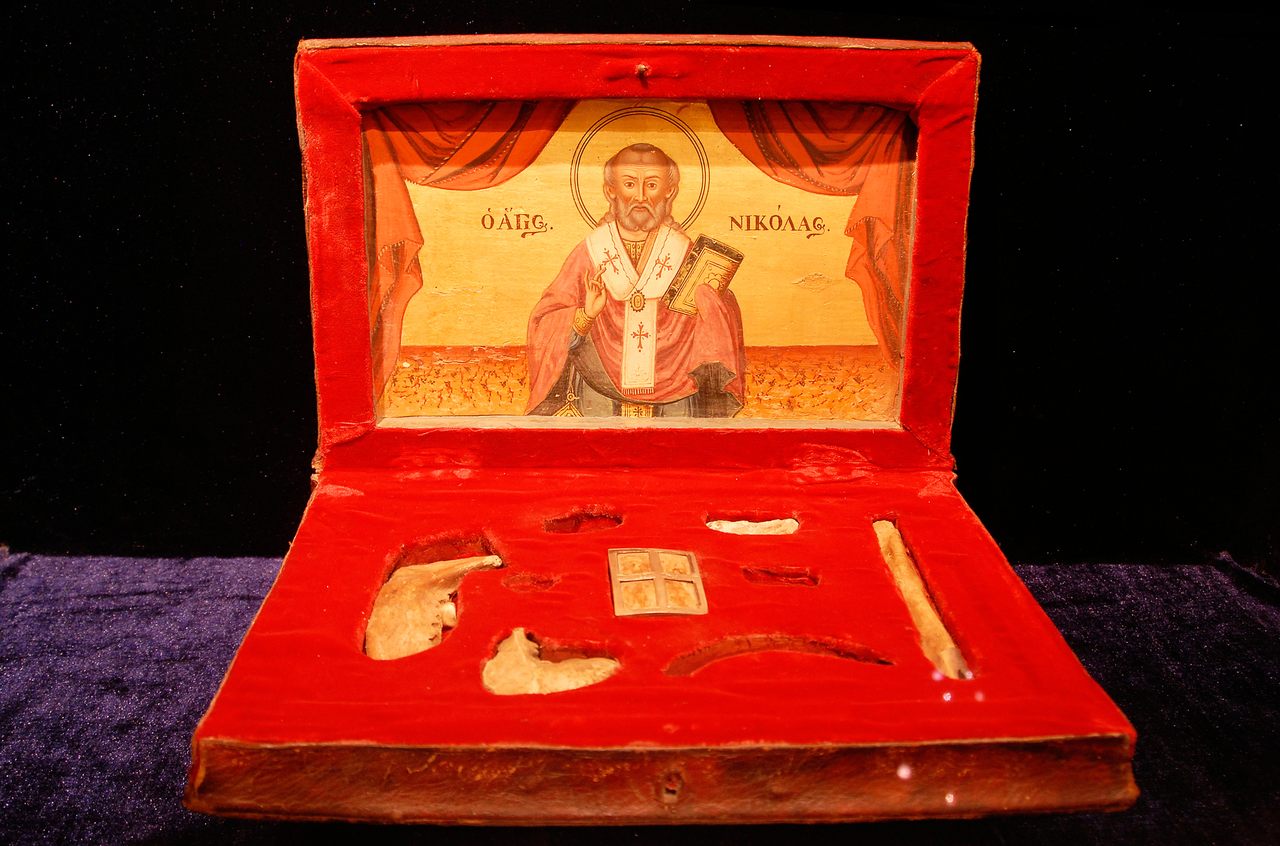Holy Relics and Reliquaries
In the Middle Ages, the demand for holy relics was on a steady rise. Catholicism was the foundation upon which medieval European society was built, and holy relics are “as old as the faith itself and developed alongside it.” A holy relic can be an object with which a saint allegedly had contact (such as bits of the True Cross of Jesus), the body—or body parts (such as the Virgin Mary’s breast milk)—of a saint themself, or even a place of religious significance (such as the city of Rome) (2).
Christians in the Middle Ages believed that relics possessed powers of healing by virtue of having come into contact with the holiest of holies, and that seeking out such people, places, and things could bring one closer to God. With this belief came the practice of taking pilgrimages to witness relics in person, journeys which “served a variety of functions: a pilgrim might set out to fulfill a vow, to expiate a crime, to seek a miraculous cure, or simply to deepen his or her faith” (4). In fact, the Knights Templar were originally created in part to protect pilgrims on their journeys, as they were susceptible to bandits (3). Late in the Middle Ages, pilgrims began to travel in part to gain indulgences, or a promise from the Church to intercede with God on a layman’s behalf, for the forgiveness of their sins and a better bet of making it to heaven (4).
Every precious artifact needs an equally fine vessel to carry it, and that’s where reliquaries come into the picture. A reliquary is both a storage and a display case for holy relics, and they are often valuable art pieces in and of themselves, made from the finest materials, as suits the items they contain. As written by Barbara Drake Boehm in an article published by the Metropolitan Museum of Art:
“Medieval reliquaries frequently assume the form of caskets (chasses), but complex containers in the form of parts of the body, usually mimicking the relics they enshrined, are one of the most remarkable art forms created in the Middle Ages for the precious remains of saints. [...] Reliquaries were sometimes created expressly for privileged individuals or purchased by them. The faithful of humble means might still acquire a souvenir badge at the shrines of saints that called to mind the precious works of art associated with them. Those [reliquaries] that survive bear precious witness to exceptional artistic creativity inspired by contemporary faith” (2).
If you’d like to take a scroll through some more pictures of the reliquaries that the Metropolitan Museum of Art has in their collection, click here.
Begging, Borrowing, and Stealing for Jesus
The desire to possess holy relics was so great that not only was there a non-zero chance of a parish’s relics being stolen to be displayed by another (as in the case of the bodies of St. Mark in Venice, St. Nicholas in Bari, and St. Foy at Conques, just to name a few) (2). Not only that, but it wasn’t uncommon for scammers to sell fraudulent relics. This practice was even prominent enough to warrant comment by Geoffrey Chaucer in The Canterbury Tales, wherein he wrote up several scathing caricatures of clerical figures who were on a pilgrimage to Canterbury, including the character of the Pardoner, who was one such seller of fake holy goods. For Chaucer to have created such a character, there must have been quite the market for holy relics, which would naturally have been taken advantage of by men like the Pardoner (3).
According to the Museum of Hoaxes, some truly strange false relics were on display during the Middle Ages. For example, one church that boasted their possession of the brain of St. Peter turned out to possess only a pumice stone, as revealed when the relic was moved by accident. Multiple churches claimed possession of Christ’s foreskin. Based on numbers alone, some of them had to be lying (accidentally or otherwise), which was a common problem: there were multiples of just about every relic. There was monetary gain in the trade of false relics not just for individual con artists, but for whole towns, as pilgrimages did much to bolster local economies, which incentivized smaller churches especially to obtain relics, though they were naturally reluctant to buy relics, for fear of them being fake. That’s where relic heists came in, as in the cases of saints' bodies getting snatched up (4).
Works Cited
(2) Boehm, Barbara Drake. “Relics and Reliquaries in Medieval Christianity | Essay.” The Metropolitan Museum of Art, April 2011, https://www.metmuseum.org/toah/hd/relc/hd_relc.htm.
(3) Cybulskie, Danièle. “Medieval Pilgrimages: It’s All About the Journey.” Medievalists.net, 30 August 2024, https://www.medievalists.net/2024/08/medieval-pilgrimages/.
(4) “The Medieval Relic Trade.” The Museum of Hoaxes, https://hoaxes.org/archive/permalink/the_medieval_relic_trade/.
(5) “True Cross Of Christ Relic.” Gettysburg Museum Of History, https://www.gettysburgmuseumofhistory.com/portfolio/img_4614/.
(6) “Workshop of Niclaus Gerhaert von Leyden | Reliquary Bust of Saint Barbara | German.” The Metropolitan Museum of Art, https://www.metmuseum.org/art/collection/search/464128.





This is a very well developed and articulated post. I, too, had a holy relic as my research topic. The holy grail is an object of many desires that allegedly has the ability to purify, heal and unify. It is also believed that it symbolizes a kind of mystical union with God.
ReplyDeleteThis was a completely new topic to, so I appreciated all of the details and images you included. The fake brain of St. Peter was something I found super cool, too.
ReplyDeleteThis is a very well articulated post, and I enjoyed learning more about holy relics!
ReplyDeleteI find it fascinating how incredibly sought after these relics were, because it seems that nothing now can compare to such a value as to what the people of this time period had held these holy relics to.
ReplyDeleteI wonder what kind of false relics would be attempted to be peddled by people? Would they be simple fakes of existing relics, or would these sellers being making their own relics and weaving stories of their importance? Perhaps if people were desperate enough to get their ands on an artifact they would buy into these fakes.
ReplyDelete